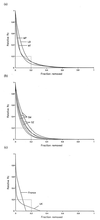Heterogeneities in the transmission of infectious agents: implications for the design of control programs
- PMID: 8990210
- PMCID: PMC19338
- DOI: 10.1073/pnas.94.1.338
Heterogeneities in the transmission of infectious agents: implications for the design of control programs
Abstract
From an analysis of the distributions of measures of transmission rates among hosts, we identify an empirical relationship suggesting that, typically, 20% of the host population contributes at least 80% of the net transmission potential, as measured by the basic reproduction number, R0. This is an example of a statistical pattern known as the 20/80 rule. The rule applies to a variety of disease systems, including vector-borne parasites and sexually transmitted pathogens. The rule implies that control programs targeted at the "core" 20% group are potentially highly effective and, conversely, that programs that fail to reach all of this group will be much less effective than expected in reducing levels of infection in the population as a whole.
Figures


References
-
- Anderson R M, May R M. Infectious Diseases of Humans: Dynamics and Control. Oxford: Oxford Scientific; 1991.
-
- Scott M E, Smith G. Parasitic and Infectious Diseases Epidemiology and Ecology. New York: Academic; 1994.
-
- Manning S D, Woolhouse M E J, Ndamba J. Int J Parasitol. 1995;25:37–42. - PubMed
-
- Grenfell B T, Dobson A P. Ecology of Infectious Diseases in Natural Populations. Cambridge, U.K.: Cambridge Univ. Press; 1995.
-
- Morand S, Manning S D, Woolhouse M E J. Proc R Soc London Ser B. 1996;263:119–128. - PubMed
Publication types
MeSH terms
Grants and funding
LinkOut - more resources
Full Text Sources

